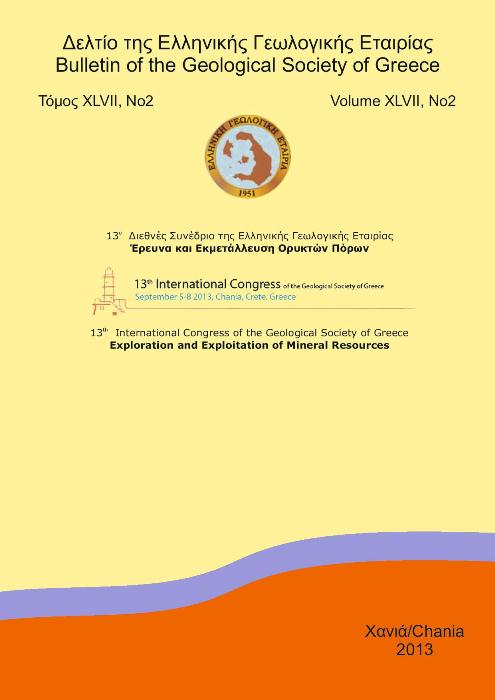GENESIS AND PHYSICAL CHARACTERISTICS OF THE NEOGENE RED BEDS FROM THE CEDARHILS OF THESSALONIKI, MACEDONIA , GREECE
Περίληψη
The genesis and the physical characteristics of the Neogene red beds of the cedar hills surrounding Thessaloniki are studied in this paper. The peri-urban forest, which covers these hills, has a 3,022 ha area. The topographic relief is smooth and is divided in eight small drainage basins, tapped through small creeks. The elevation of the surrounding hills varies between 85 and 560 m. The dominant land slopes vary between 20 and 55%. All the samples are coarse grained, poorly sorted and friable and present earthy lustre and red colour because of the extensive presence of iron oxides. Angular to sub-angular rock fragments derived from the metamorphic bedrock are very common. Petrographically, the studied red beds belong to the clayey sands. The extended presence (41-66%) of coarse silt and sand size grains (>20 pm) in the samples suggests a mild intensity of in situ weathering of the bedrock. X-ray diffraction analysis of the coarsest fractions 250-20 pm and 20-2 μιτι revealed in decreasing abundance the presence of quartz, feldspars, epidote, micas, chlorite, pyroxenes, amphiboles, and talc. These fractions contain the 2M polytype of mica, while in the fraction <2 pm the 1Μα polytype of illite predominates. In the clay fraction (<2 pm) illite, smectite, and chlorite predominate. The presence of mixed-layer minerals is limited, testifying the almost complete character of hydrolysis of the primary minerals. The formation of red beds took place on low relief land under alternating wet and dry seasons, which prevail in the eastern Mediterranean region since Neogene. The clay minerals are the in situ weathering products of the primary minerals of the greenschists, gneisses and gabbros predominating in the studied area. The extensive presence of clay size grains (11-26%) in the samples, their poor sorting, and their sub-angular morphology, indicate that the red beds are texturally immature. In addition, the abundance of feldspars and Fe-Mg minerals reflects mineralogical immaturity. The low relief and the long-lasting tectonic stability in the Thessaloniki district were essential for the significant thickness of the red beds. The oxygen isotope data of the <0.2 pm fraction (+18.2 to +18.8%o) confirm the pedogenic origin of the clay minerals present. The red beds studied present low plasticity with liquid limit (WÏ) 26.9 to 33.4% and plasticity index (lp) 9.1 to 17.3%. In addition, they have high consolidation index (lc) values (1.03 to 2.28). The swelling potential is low to medium and the activity varies between 0.5 and 1.0. The consolidation and induration degree of the samples analyzed is low, because of the great range of their mineralogical composition and the mild conditions of pressure and temperature to which they have been submitted. The studied red beds are not considered problematic for the foundation of various constructions on them.
Λεπτομέρειες άρθρου
- Πώς να δημιουργήσετε Αναφορές
-
Tsirambides, A. (2018). GENESIS AND PHYSICAL CHARACTERISTICS OF THE NEOGENE RED BEDS FROM THE CEDARHILS OF THESSALONIKI, MACEDONIA , GREECE. Δελτίο της Ελληνικής Γεωλογικής Εταιρείας, 36(2), 708–716. https://doi.org/10.12681/bgsg.16801
- Ενότητα
- Παλαιοντολογία, Στρωματογραφία και Ιζηματολογία

Αυτή η εργασία είναι αδειοδοτημένη υπό το CC Αναφορά Δημιουργού – Μη Εμπορική Χρήση 4.0.
Οι συγγραφείς θα πρέπει να είναι σύμφωνοι με τα παρακάτω: Οι συγγραφείς των άρθρων που δημοσιεύονται στο περιοδικό διατηρούν τα δικαιώματα πνευματικής ιδιοκτησίας επί των άρθρων τους, δίνοντας στο περιοδικό το δικαίωμα της πρώτης δημοσίευσης. Άρθρα που δημοσιεύονται στο περιοδικό διατίθενται με άδεια Creative Commons 4.0 Non Commercial και σύμφωνα με την οποία μπορούν να χρησιμοποιούνται ελεύθερα, με αναφορά στο/στη συγγραφέα και στην πρώτη δημοσίευση για μη κερδοσκοπικούς σκοπούς. Οι συγγραφείς μπορούν να: Μοιραστούν — αντιγράψουν και αναδιανέμουν το υλικό με κάθε μέσο και τρόπο, Προσαρμόσουν — αναμείξουν, τροποποιήσουν και δημιουργήσουν πάνω στο υλικό.







